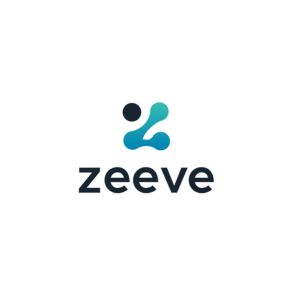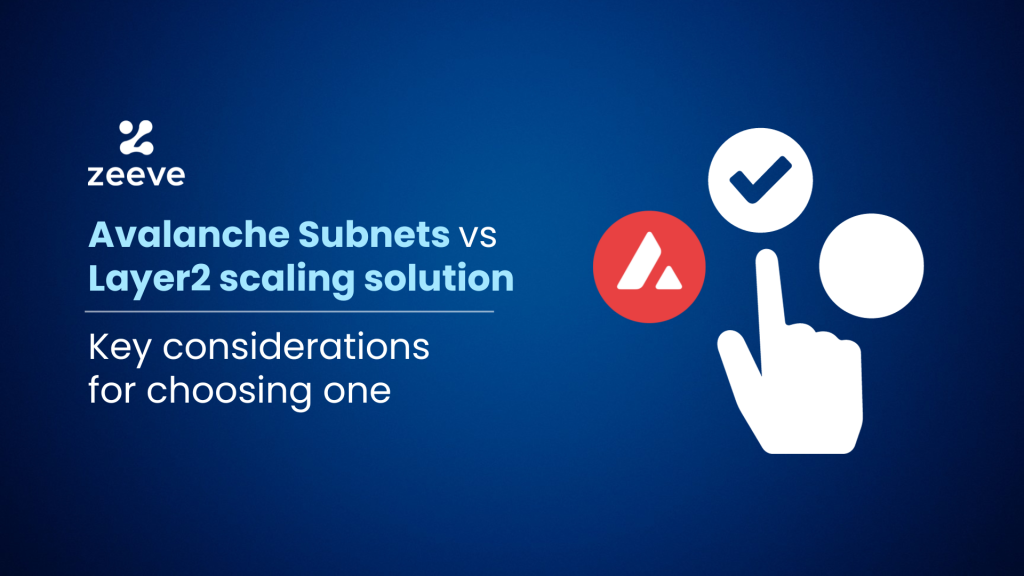Avalanche Subnets vs Layer2 scaling solution— Key considerations for choosing one
 Zeeve
Zeeve
Scalability has always been a big concern for blockchain protocols. However, a range of powerful solutions have emerged to tackle the scalability issues of blockchain protocols. Layer-2 solutions and Avalanche Subnets are the widely popular solutions for improving scalability while offering additional benefits such as a greater degree of security, composability, and interoperability.
Let’s dive deeper into the Avalanche Subnet vs Layer2 solution to understand their viability for web3 projects.
Understanding Avalanche Subnets and Layer-2 solution
Avalanche Subnets:
Avalanche Subnets is basically an appchain solution for enabling the development of sovereign, dApp-specific blockchain networks that are interconnected, allowing the whole Avalanche ecosystem to scale endlessly while offering inter-subnets Interoperability. Subnets allow implementation of custom virtual machine and meanwhile supports all the Ethereum-based smart contracts and its client functionalities. Prominent projects building their Avalanche Subnets are DeFi Kingdom, Rymedi, Meld, DOS, Dexalot, Mintara, and more.
Learn more about Avalanche Subnets from our detailed blog on this below:
A Beginner’s Guide to Avalanche Subnets
Layer2 solutions:
Layer-2 scaling solutions or L2s refer to the blockchain networks built on the top of Layer-1 blockchains, for example Ethereum. Similar to Avalanche Subnets, L2 scaling solutions aim to address the scalability issues and thereby improve the efficiency of underlying main blockchains. Layer-2 take the transaction load off from the Layer-1 to process transactions off-chain while still remaining connected to L1 for leveraging security and trustlessness. Polygon zkEVM, Optimism, Arbitrum, Starknet, zkSync Era are some of the popular Ethereum L2s.
Learn more about Layer-2 solutions and application-specific chains from our detailed guide mentioned below:
Comprehensive Guide on Layer 2, Sidechains and AppChains
Key factors for choosing between Avalanche Subnets vs Layer2 scaling solution
Let’s dive into the analysis of Avalance Subnets vs layer-2 solutions on multiple parameters, enabling enterprises and dApp projects to understand its significance:
Degree of Scalability:
Subnets or Layer-2s— the blockchain ecosystem you choose— it must deliver the required throughput of your dApp. Further, the dApp should scale over time with a growing number of daily active users and transactions.
Avalanche Subnets offer better scalability than Layer-1, for example the C–chain on Avalanche is designed to offer 4,500 TPS. However, subnets are designed specifically to offer modularity and sovereignty.
Layer-2 solution, on the other hand, like rollups also offer higher scalability. For example, Polygon zkEVM claims to offer a lower throughput of 2,000 TPS. Also, zkSync offers Ethereum-based ZkRollups that reportedly offer 100,000 TPS. Hence, if your project needs massive scalability, then Layer-2 solutions like Rollups, sidechains, and Plasma chains are the way to go.
Key factors for adoption:
What are the TPS requirements of your project?
What’s the current and future number of DAU– daily active users?
Does your project need to scale with future demand?
Level of Security
Having reliable security and full decentralization must be another key considerations for dApps, besides scalability. Speaking about Avalanche Subnets, they need to choose their own validators and maintain their own security as independent chains, which can be intermediating and vulnerable to attacks.
Regarding Layer-2 solutions, they are rich in security. L2 solution like rollups can inherits security from the main chain (L1) and therefore, they ensure optimal security without compromising on decentralization. There’s no need for setting up new validators or security or consensus mechanism. Projects needing robust security should choose Layer-2 solution to avoid hassle and security-related issues.
Key considerations for adoption:
Are you confident about maintaining security on your project?
Will you use validators and consensus from mainchain?
Do you want to adopt a different and unique consensus other than Layer-1?
Customizability
Avalanche Subnets are designed with a focus on customization. You can customize tokenomics, gas fees, validator requirements, virtual machine, and logics.
Whereas, Layer-2 solutions will only allow for customization if you are launching your own L2 chain, for example– Rollups. Deploying your dApp on any public L2 chain will require you to comply with the existing ecosystem parameters.
Hence, Avalanche Subnets is definitely the ideal solution if your project needs customizability instead of using a generic ecosystem.
Key factors for adoption:
Will your dApp custom tokens, gas fee, on-chain governance, etc?
Does your dApp has any dependency on Layer-1?
Customizability or security— which is more important for you?
Modularity
Subnets are high in modularity as they more flexible than Layer-2s. For example, one can create a Subnet to run a decentralized exchange while another Subnet can be used for a payment gateway. These two different Subnets will run parallel, but they will be interconnected.
Layer-2 solutions, like rollups also offer modularity as you can create different rollup chains for specific use cases as well as offload some functions like execution, settlement, and consensus to different layers. But, the same level of ease will be difficult to achieve in case of L2s. Hence, Subnets is the recommend for this requirement.
Key things to consider:
Does your business need various use case-specific L2s or Subnets?
Do you want to specialize some of your dApp’s functionalities?
Will your project needs customizability, along with modularity?
The need for Interoperability
Subnets are powered with ‘Avalanche Warp Messaging’ that enables cross-subnet communication and meanwhile allows projects to implement arbitrary communication protocols between two different Subnets.
The same level of interoperability can be hard to achieve in case of layer-2 scaling solutions because they lack cross-layer (L2 to L2) communication. Communicating with Layer-2 requires you to communicate with Layer-1 first, which is practically a time-taking and inefficient interoperability approach.
Therefore, interoperability-focused dApps should go with Avalanche Subnets.
Key things to consider for adoption:
How frequently your dApp needs inter-protocol communication?
Will your dApp allows users to engage in cross-dApps activities, like trading assets?
Does your project want to use logics and data from other dApps?
Privacy of on-chain data
Privacy is very important for all kinds of dApps. Avalanche Subnets allow projects to keep their data and other information private by creating their own appchains. The data here is only accessible to a set of authorized validators.
Taking about Layer-2 scaling solutions, projects can build their own Rollup chain, for examples, with Polygon CDK. These types of chains offers private appchain environment that maintains data confidentiality and safety.
As we see, choosing between Polygon supenets vs Layer-2 solutions on ‘Privacy parameter’ seems difficult. But, projects that needs customizabiity and Interoperability aside from privacy, Supernets is for them. If not, then Layer-2 solutions works the best.
Key considerations for adoption:
Is your organization strive to keep the data and information private?
How crucial is the confidentiality of data in your project?
Private or open— which ecosystem suits your use case?
Dependency on main chain
Avalanche Subnets, as we know, are independent blockchains that can specificity their tokenomics, execution logic, maintain state, determine fee regime, etc. They have zero dependency on main chain.
Layer-2 solutions, as the name suggests, they are built on layer-2 and hence depend on main chain for reliable security and authenticity. So, for projects looking for sovereignty and no Layer-1 dependency, Avalanche Subnets is a viable choice.
Key things to consider:
Is your project capable of maintaining robust security on its own?
Can you see any impact of having dependency on mainchain?
How important is application-specific customization for your project?
Costs and resources
The threshold of bearing operational cost like computation fee, validators’ incentives, and infrastructure management costs are different for every projects. Likewise, the ability to manage hardware/software requirements differs.
Avalanche Subnets are sovereign blockchain, hence they need to bear cost of validators, computation, and other costs. Plus, their hardware and software requirements for Subnets are delicate.
But, in Layer-2 solutions, you do not need to bootstrap infrastructure or validators because Layer-1 provides all of these.
Key things to consider:
Will your users pay for high transaction fees?
Can you manage validators and their incentives?
How challenging is to manage hardware and software infrastructure for you?
Here’s a brief comparison:

Scale your web3 project with Zeeve
Choosing the right blockchain ecosystem is critical for every project. With a core analysis of Avalanche Subnets vs Layer-2 solutions, you can make the right decision. However, if you still come across any challenges, Zeeve is happy to help. Zeeve offers all the things needed for seamless launch of Subnets and L2s, such as scalable nodes, white-labeled explorers, testnet faucets, data indexers, and plug-n-pay development tools.
Plus, our services includes security and reliability with ISO 27001 and SOC 2 Type 2 compliance and enterprise-level SLA. For more information on how Zeeve is simplifying the launch of Subnets, Rollups, appchains, and all the other layer-2 scaling solutions, connect with us. Drop us your queries via email or schedule one-to-one call for detailed discussion.
Subscribe to my newsletter
Read articles from Zeeve directly inside your inbox. Subscribe to the newsletter, and don't miss out.
Written by

Zeeve
Zeeve
Zeeve is an enterprise-grade low-code Blockchain Infrastructure-as-a-Service platform, compliant with ISO 27001, SOC2 Type II, and GDPR standards. We are the leading provider of Rollups-as-a-Service, dedicated node infrastructure, and hosted subgraphs. All the infrastructure managed by Zeeve includes 24x7 monitoring, Enterprise SLA, 99.9% uptime guarantee, and management dashboards to ensure a secure and scalable infrastructure. With support for all major Blockchains, 27,000+ platform users, and 40+ enterprise clients, Zeeve stands tall as the global go-to provider for Web3 infrastructure.
